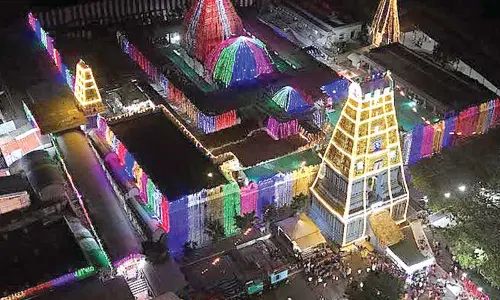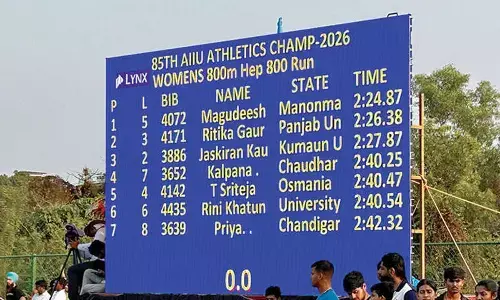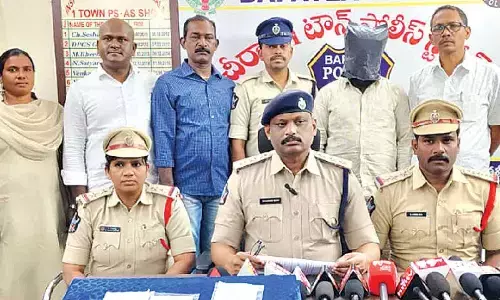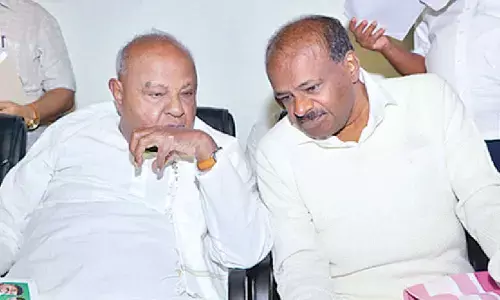Through the people's lens: Modi's development model so far

Through The People\'s Lens: Narendra Modi\'s Development Model So Far. Story of Modi’s development model so far: Cutting health and education expenditure, forcing land acquisition, buying expensive jets and unsafe nuclear power, benefitting Big Business, diluting employment guarantee, fanning communal fires, exploiting Ganga, curbing dissent and shielding governance from public scrutiny.
Story of Modi’s development model so far: Cutting health and education expenditure, forcing land acquisition, buying expensive jets and unsafe nuclear power, benefitting Big Business, diluting employment guarantee, fanning communal fires, exploiting Ganga, curbing dissent and shielding governance from public scrutiny.
If we separate Modi government’s actions from mere words and assess its priorities from the former, there is now enough evidence to form a clear picture. The picture that emerges is one of grossly skewed priorities.
.jpg)
Whatever Prime Minister Modi might say about working in the interest of farmers, transparency, cleanliness, environment and make-in-India, the concrete actions show otherwise. Let us look at some of the major policy actions initiated in the past one year that are signatures of this government. They indicate a disregard for people’s needs of livelihood, education, health and sanitation, a legitimisation of usurp of India’s natural resources and environment by big commercial interests, and a reinforcement of this exploitative process by curbing dissent and diluting mechanisms of transparency and accountability in governance.
Fund cuts in health, education, drinking water and sanitation, and women and child development
Four important Ministries and sectors that constitute bulk of the social infrastructure – Health and Family Welfare, Women and Child Development, Drinking Water and Sanitation, and Human Resource Development (including education) – face a total cut in funds of INR 40,205 crore in 2015-16 as compared to 2014-15 budget. This includes both Central Plan fund and Centre’s assistance to State and UT Plan fund.
We compare this year’s budget with previous year’s budget estimate rather than actual expenditure as the budget estimate indicates government’s intent. The government first reduced the 2014-15 budget allocation for Ministry of Health and Family Welfare by 20% (i.e. by about INR 6,500 crore) in a revision in December 2014, and later maintained that reduced allocation in the 2015-16 budget. The budget for Ministry of Women and Child Development has been reduced by 52% or INR 10,818 crore, and that for Ministry of Drinking Water and Sanitation by 59% or INR 9,026 crore. It must be noted that the entire Swaccha Bharat Abhiyaan is included in Drinking Water and Sanitation sector. In other words, in spite of Modi’s rhetoric of Swaccha Bharat the total fund allocation in 2015-16 for all governmental programmes of cleanliness, drinking water and sanitation improvement has actually gone down by 59% from budgeted allocation of 2014-15. Finally, the budget for Ministry of Human Resource Development, that includes school education, literacy and higher education, has been cut by 20% or INR 13,853 crore. Majority of this cut is in programmes of school education including setting up model schools at Block level. There is no cut in higher education fund.
While on the one hand the government has reduced these four social infrastructure sectors’ budget by INR 40,205 crore, on the other hand in FY 2014-15 it willingly lost INR 75,592 crore of revenue due to incentives and waivers on customs duty for gold, diamond and jewellery, and another INR 62,399 crore of revenue on account of exemptions on corporate income tax. The Statement of Revenue Impact of Tax Incentives describes these incentives and exemptions as indirect ‘subsidy’ to preferred tax payers. There are several other categories of exemptions as well, but here we mention only these two as they go mainly to the cash-rich companies and wealthy individuals.
Buying expensive Rafale fighter jets and unsafe nuclear power: will they provide security?
Narendra Modi has signed two controversial deals during his visit to France - related to Jaitapur Nuclear Power Plant and the Rafale aircraft. It appears that both these deals will benefit the French companies, Areva and Dassault, respectively, which will provide the products, more than India. Dassault, specially, would have closed down if this deal was not signed. On the other hand the deal will have adverse impact on the public sector unit Hindustan Aeronautics Limited as the contract for domestic production of these aircrafts, after 36 of them arrive in ‘ready to fly’ condition from France, will probably go to some private company. The story of crippling a public sector unit by promoting the private players will be repeated once again in the country. Narendra Modi has already prepared the ground for this by opening up the defence sector to FDI upto 49% of investment, which the previous government was not willing to accede to. The Russian aircraft Su-30 would have cost about half of Rafale. Rafale has been rejected by a number of countries. It is not clear why Narendra Modi wants to buy three dozen of these when the country possesses the capacity to produce its own Tejas Mk2, an aircraft of same category.
The Jaitapur Nuclear Power Project, located in Maharashtra's Ratnagiri district, has been stalled for the last five years as there is stiff opposition on ground. The farmers who will lose land or whose farming will be affected in this very fertile region are opposing the projects on grounds of displacement, damage to environment and safety issues. After the Fukushima accident now people know how dangerous it is to have a nuclear power plant in your vicinity. Two Evolutional Pressurized Reactors, each of 1650 MWe, are proposed here initially, with the final target of achieving 9900 MWe capacity from six reactors.
About 1000 hectares will be lost to the plant and a bigger area affected due to radiation.
Pushing undemocratic changes to 2013 Land Acquisition Act
The Ordinance for amending the 2013 Land Acquisition Act was introduced by Modi government in December 2014, and presented as a Bill in February 2015 with some further modification made in March 2015. The amendments have undone almost all positive achievements of the 2013 Act for the sake of easing up procedures for private industry and facilitating ‘Make in India’ campaign.
The conditions of 70% (or 80%) consent and Social Impact Assessment have been exempted for five areas – industrial corridors, PPP projects (excluding private hospitals and colleges), rural infrastructure, defence and defence production, and affordable housing. It must be noted that practically any major project of private sector can be included in one of these areas. In addition, the prescription to limit use of agricultural land and to avoid multi-crop land has been removed. This is bound to compromise India’s food security. Furthermore, if an offence is committed by a government official or the head of a department, no citizen can file FIR or go to court for the official’s prosecution without prior sanction of the government.
By depriving farmers from having any say in the process of land acquisition, the core principles of latest Bill have become similar to the colonial Act of 1894. It is strange that amendments to the 2013 Act are being proposed citing shortage of land for industry, whereas lakhs of acres of unutilized lands are already lying with the Central and State governments. For instance, over 35% of land earmarked for SEZs lies unutilized and lakhs of acres is locked with sick industry.
Shallowness of ‘Make in India’
It is ironical that the government is doing all this damage while simultaneously claiming to promote ‘Make in India’ policy. How will depriving the majority of our population from basic healthcare and education facilities prepare the workforce required for skilled and productive economic activities? How will snatching agricultural lands from farmers and giving to factories help in a sustainable strategy for ‘Make in India’? How will the procurement of “ready to fly” Rafale jets, thereby diverting a large chunk of defence budget away from potential domestic manufacturing, contribute to ‘Make in India’?
Unfortunately the ‘Make in India’ strategy so far seems to rely too much on inviting foreign investment and favouring selected business houses and too little on involving India’s mass of small manufacturers, entrepreneurs, and farmers. Heads of some of India’s largest business groups have accompanied the PM in most of his high profile foreign visits. Those visits have been largely about inviting investment from foreign MNCs and signing business deals between foreign and Indian MNCs. For instance, bulk of the benefits of USD 22 billion deals signed during PM’s recent visit to China has gone to two particular business houses of India. Most of the deals made in PM’s foreign visits are either about directly procuring ‘readymade’ foreign technology that India does not have or about inviting MNCs to open mass production facilities in sectors in which Indian industry already has competence. 2015 Land Bill offers to ease up forcible acquisition of farmers’ lands for these factories.
All such mega investments will no doubt add to India’s GDP growth but the real questions we need to ask are, “Will they build widespread competence amongst the bulk of India’s manufacturers and farmers and generate enough employment for India’s population?”, and “Will they build domestic competence in development and manufacture of advanced technology?” ‘Not likely’ seems to be the answer to both questions as of now.
For a ‘Make in India’ process to succeed in true sense, it must include agriculture, forestry and related economic activities, and involve farmers and forest dwelling people as stakeholders in form of owners and participants in those activities. Almost all industrial supply chains begin from farmland, forests or mines. Unless the communities who have been living in harmony with these natural resources for ages and who possess valuable traditional knowledge are engaged as equal partners and ‘value adding producers and suppliers’ to successive links in the chain, the entire ‘Make in India’ strategy will fall flat. Such a strategy that undermines the role of indigenous farming and tribal communities will most likely result in massive displacement and distress migration of the people and commercial exploitation of the environment. On the contrary, a strategy that views small farmer and tribal communities as trustees of natural resources, grants them negotiating right and connects them with local clusters of small manufacturers, designers and markets can meet multiple goals of employment, economy, equitable wealth distribution and sustainable development.
In addition, the policy of low priority accorded to health and education needs to be reversed as universal health care and universal education are preconditions to developing productive workforce and enabling people to access better opportunities for employment and entrepreneurship. Without a strategy that involves small manufacturers, entrepreneurs and farmers as equal value adding partners in a collaborative system and provides good health care and education to all, we cannot conceive of building a robust domestic industrial competency.
Contradiction of starting Jan Dhan Yojana and undercutting employment guarantee scheme
Jan Dhan Yojana is a much touted social security program of Modi that aims to open saving bank accounts for the poor and thereby provide them access to banking services and directly transfer benefits to them under various welfare and job schemes. The intention may be good and it is hoped that this will cut leakages and make benefits transfer process efficient. The ground reality, however, reveals that there has been little follow up after the first round of outburst of opening a record 11.5 crore bank accounts in five-six months. Majority of the accounts have zero balance. Moreover, total MGNREGS disbursal has dropped sharply. Instead of re-assessing and course-correcting the Jan Dhan scheme, Modi has gone ahead and announced a pension and two insurance schemes for the poor on a similar scale.
Banking, insurance and pension schemes will be futile without enabling the poor to get employment and regular earning. MGNREGS was a positive initiative undertaken by the UPA government in the direction of creating employment by engaging the poor in productive work such as building local infrastructures. It did create lots of rural employment, slowed down distress migration, and acted as a security valve in times of calamities such as crop failure. However UPA could not build on the initial momentum, the work options under MGNREGS did not expand, and the total number of jobs offered showed a decline since 2011. Instead, the government could have offered the rural poor a steadily expanding set of options of creating infrastructures such as schools, hospitals, pucca roads, drainage, water supply, etc.
Modi government has accelerated the decline. The first quarter of 2015 saw the steepest drop in person-days of employment in the history of MGNREGS – more than half from the first quarter of 2014. That too in the period when a lot of farmers suffered from crop damage due to heavy rains and hailstorms.
Thus the small and medium farmers of India, after being hit in the immediate term by inclement weather, are now facing doom in the short-medium term by shrinking security net of MGNREGS and in the longer term by government’s enthusiasm to legalise forcible grabbing of their farmlands for private industry.
Exploitation of Ganga
Clean Ganga mission has been initiated with the participation of five ministries – Water Resources, now going to be called Water Resources, River Development and Ganga Rejuvenation; Environment and Forests; Power; Tourism; and Surface Transport and Shipping. The Tourism ministry is going to look into how to promote tourism all along Ganga, the Power ministry is going to explore new opportunities of generating hydro-electricity and the Surface Transport and Shipping ministry will see how to use the waterways for facilitating trade.
Hence the mission clean Ganga is not just about cleaning Ganga. In that only the water resources and environment ministries would have been sufficient to undertake the task. The other three ministries are being involved with the objective of commercial exploitation of Ganga.
There have been protests earlier against dams on river Ganga. Persistent efforts of individuals such as Sunderlal Bahuguna and former professor of IIT Kanpur G D Agarwal against big dams on the Ganga have generated awareness about the dangers of such projects in the ecologically fragile region. Lakhs of families who have been displaced by big dams on the Narmada river, and who face submergence because of government’s decision to raise dam height in violation of Narmada Water Dispute Tribunal Award, still await rehabilitation. All this demonstrates government’s enthusiasm to push large projects without caring for or preparing to compensate the destruction caused to the environment and the lives of displaced communities.
One can find out the impact of big tourism activity on any of cities along Ganga and determine its contribution to making it dirty. Spitting, throwing waste, polythene in Ganga is being thought of as a punishable offence. What is Narendra Modi going to do about the untreated sewage which is allowed to meet not just Ganga but virtually every river in the country including Sabarmati? When will that become a crime?
Modi’s plan to clean Ganga with the involvement of agencies which might be looking to make money from their projects could spell a disaster for the holy river and the environment even if we choose not to talk about the lakhs whose lives and livelihood will be affected when these ambitious projects are undertaken. For example, the traditional boatmen and fisherfolk communities are already wary of Modi’s plans.
Increasing communalisation
With the capturing of power at the centre, the people associated with Sangh Parivar have been emboldened to say things in public which they hitherto mostly kept to themselves. Love Jihad, Ghar Wapsi, building a temple for Nathuram Godse, talking of taking away the voting rights of Muslims, asking Hindus to produce more children, demanding right to start performing puja in Taj Mahal, are some examples. Attacks on religious institutions belonging to minorities, especially Churches, including placing a Hindu deity idol in one of them, are vitiating the communal harmony atmosphere of the country. While such communalisation may help BJP to polarise votes in its favour it will have long term effects in terms of distorting the relationship among different communities. For example, in Gujarat, which had been described by VHP President Ashok Singhal as a laboratory for communal experiments after the 2002 massacre there, today the Hindu and Muslim populations are totally segregated, both mentally as well as physically. The VHP President had also claimed then that they will convert the whole country into Gujarat. For now, they seem to be succeeding in their design. By the time they leave the seat of power they would have caused irreparable damage.
Shrinking space for dissent and increasing absence of governance accountability
Another worrying sign is the increasing tendency of the state to label those who disagree and oppose its model of development as acting against national interest. As if the government’s idea of development is sacrosanct and it alone can claim to act in national interest! This brazenly self-centered and dictatorial attitude of the government has resulted in harassment of civil society organizations (CSOs). Bank accounts of a number of organisations which question government's policies, especially those receiving foreign funds, are being seized. But the Sangh Parivar has received large funds in the past for its Ram temple movement from Hindus settled abroad to disturb the communal amity atmosphere of the country and still continues to receive funds for its communal education projects.
While on the one hand the government seems determined to curb democratic right of citizens and CSOs to critique its actions, on the other hand it is trying to make itself less transparent and accountable. It has not appointed Chief Information Commissioner for the past eight months and Information Commissioners for the past one year, thereby rendering the Right to Information (RTI) processes inefficient and slow. Consequently the backlog of appeals and complaints pending in the Commission has swelled to about 40,000. Likewise, the posts of Chief Vigilance Commissioner and Lok Pal have been lying vacant for a long time. Therefore it appears that by procrastination in these crucial appointments the government is weakening the processes that hold its own governance systems accountable to the public. It is indeed surprising that the PM claims to be working for transparency in governance.
In conclusion
In other words, by its concrete actions the government is giving a clear message to its citizens, “Do not believe when we speak for health, education, cleanliness, farmers, transparency, and ‘Make in India’. Judge us by our actions, where we put taxpayers’ money, and what the PM spends his time lobbying for. We are intent on undermining public health care, school education, farmers’ livelihood, food security, sanitation and cleanliness. At the same time we hope to convince some multinational companies to open factories in India where a fraction of the people displaced from farmland will find work, that too provided they skill themselves up for the new jobs. Otherwise some of the educated youngsters from cities will operate machines in those factories. How will majority of the population that remains poorly educated and under-nourished find any productive and dignified employment? – so far we do not have a clue to that question. By legalising land grab by private industries and bypassing farmers’ consent and impact assessment, we’ll let private industries open facilities wherever they wish, be it the most fertile multi-crop land. We will tackle the civil society activists who persistently oppose our plan by painting them anti-national, blocking their funds, and diluting RTI to make it difficult for them to access information.”
Dr Rahul Pandey, Bobby Ramakant and Dr Sandeep Pandey, Citizen News Service - CNS
(Dr Rahul Pandey is an academic-entrepreneur-activist, Bobby Ramakant works on advocacy on health related issues and Dr Sandeep Pandey is with Socialist Party (India). Emails: [email protected], [email protected], [email protected])
- Shared under Creative Commons (CC) Attribution License

















